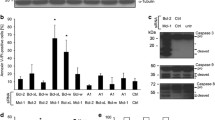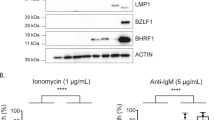Abstract
The Abelson Murine Leukemia Virus (A-MuLV) encodes v-Abl, an oncogenic form of the ubiquitous cellular non-receptor tyrosine kinase, c-Abl. A-MuLV specifically transforms murine B cell precursors both in vivo and in vitro. Inhibition of v-Abl by addition of the small molecule inhibitor STI-571 causes these cells to arrest in the G1 phase of the cell cycle prior to undergoing apoptosis. We found that inhibition of v-Abl activity results in upregulation of transcription of the pro-apoptotic TNF-family ligand tumor-necrosis factor-related apoptosis-inducing ligand (TRAIL). Similarly to BCR-Abl-transformed human cells, activation of the transcription factor Foxo3a led to increased TRAIL transcription and induction of a G1 arrest in the absence of v-Abl inhibition, and this effect could be inhibited by the expression of a constitutively active AKT mutant. Multiple pathways act to inhibit FoxO3a activity within Abelson cells. In addition to diminishing transcription factor activity via inhibitory phosphorylation by AKT family members, we found that inhibition of IKKβ activity results in an increase in the total protein level of FoxO3a. Furthermore overexpression of the p65 subunit of NF-κB results in an increase in TRAIL transcription and in apoptosis and deletion of IKKα and β diminishes TRAIL expression and induction. We conclude that in Abelson cells, the inhibition of both NF-κB and FoxO3a activity is required for suppression of TRAIL transcription and maintenance of the transformed state.
Similar content being viewed by others
References
Abelson, H.T., and Rabstein, L.S. (1970). Lymphosarcoma: virus-induced thymic-independent disease in mice. Cancer Res. 30, 2213–2222.
Advani, A.S., and Pendergast, A.M. (2002). Bcr-Abl variants: biological and clinical aspects. Leuk. Res. 26, 713–720.
Alt, F.W., Yancopoulos, G.D., Blackwell, T.K., Wood, C., Thomas, E., Boss, M., Coffman, R., Rosenberg, N., Tonegawa, S., and Baltimore, D. (1984). Ordered rearrangement of immunoglobulin heavy chain variable region segments. EMBO J. 3, 1209–1219.
Amin, R.H., and Schlissel, M.S. (2008). Foxo1 directly regulates the transcription of recombination-activating genes during B cell development. Nat. Immunol. 9, 613–622.
Baetu, T.M., Kwon, H., Sharma, S., Grandvaux, N., and Hiscott, J. (2001). Disruption of NF-kappaB signaling reveals a novel role for NF-kappaB in the regulation of TNF-related apoptosisinducing ligand expression. J. Immunol. 167, 3164–3173.
Banerjee, A., and Rothman, P. (1998). IL-7 reconstitutes multiple aspects of v-Abl-mediated signaling. J. Immunol. 161, 4611–4617.
Biggs, W.H., 3rd, Meisenhelder, J., Hunter, T., Cavenee, W.K., and Arden, K.C. (1999). Protein kinase B/Akt-mediated phosphorylation promotes nuclear exclusion of the winged helix transcription factor FKHR1. Proc. Natl. Acad. Sci. USA 96, 7421–7426.
Brunet, A., Park, J., Tran, H., Hu, L.S., Hemmings, B.A., and Greenberg, M.E. (2001). Protein kinase SGK mediates survival signals by phosphorylating the forkhead transcription factor FKHRL1 (FOXO3a). Mol. Cell. Biol. 21, 952–965.
Chen, M., and Wang, J. (2002). Initiator caspases in apoptosis signaling pathways. Apoptosis 7, 313–319.
Chen, Y.Y., Wang, L.C., Huang, M.S., and Rosenberg, N. (1994). An active v-abl protein tyrosine kinase blocks immunoglobulin light-chain gene rearrangement. Genes Dev. 8, 688–697.
Cory, S., Huang, D.C., and Adams, J.M. (2003). The Bcl-2 family: roles in cell survival and oncogenesis. Oncogene 22, 8590–8607.
Deng, Y., Lin, Y., and Wu, X. (2002). TRAIL-induced apoptosis requires Bax-dependent mitochondrial release of Smac/DIABLO. Genes Dev. 16, 33–45.
Derudder, E., Cadera, E.J., Vahl, J.C., Wang, J., Fox, C.J., Zha, S., van Loo, G., Pasparakis, M., Schlissel, M.S., Schmidt-Supprian, M., et al. (2009). Development of immunoglobulin lambda-chainpositive B cells, but not editing of immunoglobulin kappa-chain, depends on NF-kappaB signals. Nat. Immunol. 10, 647–654.
Druker, B.J., Tamura, S., Buchdunger, E., Ohno, S., Segal, G.M., Fanning, S., Zimmermann, J., and Lydon, N.B. (1996). Effects of a selective inhibitor of the Abl tyrosine kinase on the growth of Bcr-Abl positive cells. Nat. Med. 2, 561–566.
Fang, W., Rivard, J.J., Ganser, J.A., LeBien, T.W., Nath, K.A., Mueller, D.L., and Behrens, T.W. (1995). Bcl-xL rescues WEHI 231 B lymphocytes from oxidant-mediated death following diverse apoptotic stimuli. J. Immunol. 155, 66–75.
Ghaffari, S., Jagani, Z., Kitidis, C., Lodish, H.F., and Khosravi-Far, R. (2003). Cytokines and BCR-ABL mediate suppression of TRAIL-induced apoptosis through inhibition of forkhead FOXO3a transcription factor. Proc. Natl. Acad. Sci. USA 100, 6523–6528.
Green, P.L., Kaehler, D.A., Bennett, L.M., and Risser, R. (1989). Multiple steps are required for the induction of tumors by Abelson murine leukemia virus. J. Virol. 63, 1989–1994.
Hacker, H., and Karin, M. (2006). Regulation and function of IKK and IKK-related kinases. Sci STKE 2006, re13.
Hakansson, P., Nilsson, B., Andersson, A., Lassen, C., Gullberg, U., and Fioretos, T. (2008). Gene expression analysis of BCR/ABL1-dependent transcriptional response reveals enrichment for genes involved in negative feedback regulation. Genes Chromosomes Cancer 47, 267–275.
Henson, E.S., Johnston, J.B., and Gibson, S.B. (2008). The role of TRAIL death receptors in the treatment of hematological malignancies. Leuk. Lymphoma 49, 27–35.
Hosaka, T., Biggs, W.H., 3rd, Tieu, D., Boyer, A.D., Varki, N.M., Cavenee, W.K., and Arden, K.C. (2004). Disruption of forkhead transcription factor (FOXO) family members in mice reveals their functional diversification. Proc. Natl. Acad. Sci. USA 101, 2975–2980.
Hu, M.C., Lee, D.F., Xia, W., Golfman, L.S., Ou-Yang, F., Yang, J.Y., Zou, Y., Bao, S., Hanada, N., Saso, H., et al. (2004). IkappaB kinase promotes tumorigenesis through inhibition of forkhead FOXO3a. Cell 117, 225–237.
Huang, H., and Tindall, D.J. (2007). Dynamic FoxO transcription factors. J. Cell Sci. 120, 2479–2487.
Hueber, A.O., Zornig, M., Bernard, A.M., Chautan, M., and Evan, G. (2000). A dominant negative Fas-associated death domain protein mutant inhibits proliferation and leads to impaired calcium mobilization in both T-cells and fibroblasts. J. Biol. Chem. 275, 10453–10462.
Kabra, N.H., Kang, C., Hsing, L.C., Zhang, J., and Winoto, A. (2001). T cell-specific FADD-deficient mice: FADD is required for early T cell development. Proc. Natl. Acad. Sci. USA 98, 6307–6312.
Kawai, H., Nie, L., and Yuan, Z.M. (2002). Inactivation of NF-kappaB-dependent cell survival, a novel mechanism for the proapoptotic function of c-Abl. Mol. Cell. Biol. 22, 6079–6088.
Kikuchi, S., Nagai, T., Kunitama, M., Kirito, K., Ozawa, K., and Komatsu, N. (2007). Active FKHRL1 overcomes imatinib resistance in chronic myelogenous leukemia-derived cell lines via the production of tumor necrosis factor-related apoptosis-inducing ligand. Cancer Sci. 98, 1949–1958.
Klug, C.A., Gerety, S.J., Shah, P.C., Chen, Y.Y., Rice, N.R., Rosenberg, N., and Singh, H. (1994). The v-abl tyrosine kinase negatively regulates NF-kappa B/Rel factors and blocks kappa gene transcription in pre-B lymphocytes. Genes Dev. 8, 678–687.
Komatsu, N., Watanabe, T., Uchida, M., Mori, M., Kirito, K., Kikuchi, S., Liu, Q., Tauchi, T., Miyazawa, K., Endo, H., et al. (2003). A member of Forkhead transcription factor FKHRL1 is a downstream effector of STI571-induced cell cycle arrest in BCR-ABL-expressing cells. J. Biol. Chem. 278, 6411–6419.
Kruyt, F.A. (2008). TRAIL and cancer therapy. Cancer Lett. 263, 14–25.
Lee, J.Y., Huerta-Yepez, S., Vega, M., Baritaki, S., Spandidos, D.A., and Bonavida, B. (2007). The NO TRAIL to YES TRAIL in cancer therapy (review). Int. J. Oncol. 31, 685–691.
Lewis, S., Rosenberg, N., Alt, F., and Baltimore, D. (1982). Continuing kappa-gene rearrangement in a cell line transformed by Abelson murine leukemia virus. Cell 30, 807–816.
Marshall, A.J., Fleming, H.E., Wu, G.E., and Paige, C.J. (1998). Modulation of the IL-7 dose-response threshold during pro-B cell differentiation is dependent on pre-B cell receptor expression. J. Immunol. 161, 6038–6045.
Mattioni, T., Louvion, J.F., and Picard, D. (1994). Regulation of protein activities by fusion to steroid binding domains. Methods Cell Biol. 43Pt A, 335–352.
Mauro, M.J., and Druker, B.J. (2001). STI571: targeting BCR-ABL as therapy for CML. Oncologist 6, 233–238.
Modur, V., Nagarajan, R., Evers, B.M., and Milbrandt, J. (2002). FOXO proteins regulate tumor necrosis factor-related apoptosis inducing ligand expression. Implications for PTEN mutation in prostate cancer. J. Biol. Chem. 277, 47928–47937.
Muljo, S.A., and Schlissel, M.S. (2003). A small molecule Abl kinase inhibitor induces differentiation of Abelson virus-transformed pre-B cell lines. Nat. Immunol. 4, 31–37.
Newton, K., Harris, A.W., Bath, M.L., Smith, K.G., and Strasser, A. (1998). A dominant interfering mutant of FADD/MORT1 enhances deletion of autoreactive thymocytes and inhibits proliferation of mature T lymphocytes. EMBO J. 17, 706–718.
Park, S.M., Schickel, R., and Peter, M.E. (2005). Nonapoptotic functions of FADD-binding death receptors and their signaling molecules. Curr. Opin. Cell Biol. 17, 610–616.
Perkins, N.D. (2007). Integrating cell-signalling pathways with NF-kappaB and IKK function. Nat. Rev. Mol. Cell Biol. 8, 49–62.
Ramaswamy, S., Nakamura, N., Sansal, I., Bergeron, L., and Sellers, W.R. (2002). A novel mechanism of gene regulation and tumor suppression by the transcription factor FKHR. Cancer Cell 2, 81–91.
Roth, W., and Reed, J.C. (2002). Apoptosis and cancer: when BAX is TRAILing away. Nat. Med. 8, 216–218.
Scaffidi, C., Fulda, S., Srinivasan, A., Friesen, C., Li, F., Tomaselli, K.J., Debatin, K.M., Krammer, P.H., and Peter, M.E. (1998). Two CD95 (APO-1/Fas) signaling pathways. EMBO J. 17, 1675–1687.
Schaefer, U., Voloshanenko, O., Willen, D., and Walczak, H. (2007). TRAIL: a multifunctional cytokine. Front Biosci. 12, 3813–3824.
Sen, R., and Baltimore, D. (1986). Inducibility of kappa immunoglobulin enhancer-binding protein Nf-kappa B by a posttranslational mechanism. Cell 47, 921–928.
Sheehy, A.M., and Schlissel, M.S. (1999). Overexpression of RelA causes G1 arrest and apoptosis in a pro-B cell line. J. Biol. Chem. 274, 8708–8716.
Sheridan, J.P., Marsters, S.A., Pitti, R.M., Gurney, A., Skubatch, M., Baldwin, D., Ramakrishnan, L., Gray, C.L., Baker, K., Wood, W.I., et al. (1997). Control of TRAIL-induced apoptosis by a family of signaling and decoy receptors. Science 277, 818–821.
Xu, G., and Shi, Y. (2007). Apoptosis signaling pathways and lymphocyte homeostasis. Cell Res. 17, 759–771.
Zhang, L., and Fang, B. (2005). Mechanisms of resistance to TRAIL-induced apoptosis in cancer. Cancer Gene Ther. 12, 228–237.
Zhang, J., and Winoto, A. (1996). A mouse Fas-associated protein with homology to the human Mort1/FADD protein is essential for Fas-induced apoptosis. Mol. Cell. Biol. 16, 2756–2763.
Zhang, J., Cado, D., Chen, A., Kabra, N.H., and Winoto, A. (1998). Fas-mediated apoptosis and activation-induced T-cell proliferation are defective in mice lacking FADD/Mort1. Nature 392, 296–300.
Zhang, J., Kabra, N.H., Cado, D., Kang, C., and Winoto, A. (2001). FADD-deficient T cells exhibit a disaccord in regulation of the cell cycle machinery. J. Biol. Chem. 276, 29815–29818.
Zou, X., and Calame, K. (1999). Signaling pathways activated by oncogenic forms of Abl tyrosine kinase. J. Biol. Chem. 274, 18141–18144.
Author information
Authors and Affiliations
Corresponding author
About this article
Cite this article
Wilson, M.K., McWhirter, S.M., Amin, R.H. et al. Abelson virus transformation prevents TRAIL expression by inhibiting FoxO3a and NF-κB. Mol Cells 29, 333–341 (2010). https://doi.org/10.1007/s10059-010-0029-8
Received:
Revised:
Accepted:
Published:
Issue Date:
DOI: https://doi.org/10.1007/s10059-010-0029-8




